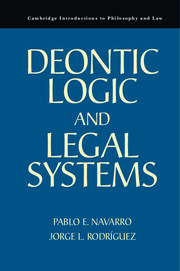Book contents
3 - Norm-propositions, Conditional Norms, and Defeasibility
Published online by Cambridge University Press: 05 October 2014
Summary
Logic of Norms and Logic of Norm-propositions
So far we have been dealing with the problem of the foundations of deontic logic, particularly with the controversial relation between propositions and norms. And although the thesis that norms are proposition-like entities is highly controversial (we have, in fact, rejected that point of view), there is no disputing the propositional character of the discourse about norms. It is unreasonable to deny the possibility of formulating true or false descriptive statements about the norms that belong to a certain normative system.
The difference between genuine norms and statements about norms is quite apparent. However, as previously noticed, the problem is that the very same words (e.g., “Parking is not allowed here”) may be used, depending on the context, either to formulate a norm (when the speaker is a norm-authority) or to express a norm-proposition (about the norms issued by a certain authority). Perhaps this ambiguity helps to explain the unfortunate reason why, although the distinction with different names has been noticed by several authors, it has received little attention in the analysis of the logic of normative discourse.
- Type
- Chapter
- Information
- Deontic Logic and Legal Systems , pp. 78 - 114Publisher: Cambridge University PressPrint publication year: 2014

